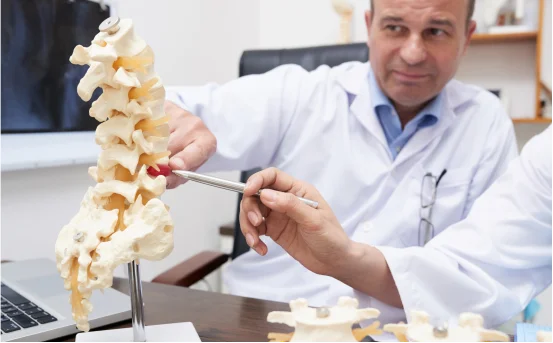What is kyphoplasty surgery offers a minimally invasive solution to restore spinal stability and relieve pain. Back pain is one of the most common health complaints worldwide, especially among older adults. While most back pain is due to muscle strain or degenerative disc disease, a significant number of cases especially in elderly individuals are caused by vertebral compression fractures (VCFs). These fractures occur when the bones in the spine (vertebrae) become weakened or brittle and collapse under pressure, leading to severe pain, reduced mobility, and visible changes in posture.
One of the most advanced and effective treatments available for this condition is Kyphoplasty surgery a minimally invasive procedure designed to stabilize fractured vertebrae, relieve pain, and restore the spine’s natural alignment. Unlike traditional open spinal surgeries that require long recovery periods, kyphoplasty is performed using small incisions, typically involves minimal blood loss, and enables quicker patient recovery.
What is Kyphoplasty Surgery?
Kyphoplasty is a minimally invasive spinal procedure used to treat vertebral compression fractures, most commonly caused by osteoporosis, trauma, or spinal tumors. These fractures occur when one or more vertebrae in the spine collapse, leading to pain, spinal deformity (like a hunchback posture), and reduced mobility.
Kyphoplasty involves inserting a small balloon into the fractured vertebra, inflating it to restore height, and then filling the space with bone cement. This stabilizes the bone and reduces pain significantly.
Kyphoplasty is often confused with vertebroplasty, a similar procedure. However, vertebroplasty doesn’t use a balloon and does not attempt to restore vertebral height.
Why is Kyphoplasty Done?
Kyphoplasty is recommended for patients who suffer from painful vertebral compression fractures that :-
-
Are caused by osteoporosis, injury, or metastatic spinal tumors
-
Do not improve with bed rest, pain medications, or back braces
-
Result in decreased height, hunched posture (kyphosis), or severe back pain
Common Causes of Vertebral Compression Fractures :-
-
Osteoporosis (the most common cause)
-
Spinal trauma or injury
-
Bone metastases (cancer spreading to the spine)
-
Multiple myeloma or other bone-weakening diseases
Who is a Candidate for Kyphoplasty?
Your doctor may consider kyphoplasty if :-
-
You have one or more recent vertebral fractures visible on MRI or X-ray
-
The fracture is less than 3 months old
-
You are experiencing moderate to severe back pain
-
Non-surgical treatments have not worked
-
You are not a candidate for open spine surgery
It is not usually recommended for chronic fractures, infections, or people with unstable neurological conditions.
How is Kyphoplasty Performed?
Kyphoplasty is typically performed in a hospital or surgical center and takes about 45 minutes per vertebra. It may be done under local or general anesthesia, depending on the patient’s condition.
Step-by-Step Procedure :-
-
Patient Preparation :- You lie face down on the operating table. The area is cleaned and sterilized.
-
Needle Insertion :- A small incision is made, and a hollow needle (trocar) is guided through the back into the fractured vertebra using X-ray imaging (fluoroscopy).
-
Balloon Inflation :- A small balloon (balloon tamp) is inserted through the needle and inflated to create a cavity and restore vertebral height.
-
Cavity Filling :- Once the balloon is deflated and removed, the cavity is filled with bone cement (polymethylmethacrylate or PMMA).
-
Stabilization :- The cement hardens within minutes, stabilizing the fracture and relieving pain.
-
Closure :- The needle is removed, and the small incision is bandaged. No stitches are usually required.
Most patients go home the same day or the next day, depending on overall health and the number of vertebrae treated.
Benefits of Kyphoplasty Surgery
Kyphoplasty offers several advantages, especially when performed early after a fracture :-
- Pain Relief :- Most patients report significant pain relief within 24 to 48 hours post-procedure.
- Spinal Stability :- By reinforcing the fractured vertebra, the procedure restores spinal stability and prevents further collapse.
- Improved Mobility :- Pain relief leads to improved movement and a quicker return to daily activities.
- Restored Height :- Inflating the balloon can help restore lost vertebral height and correct posture deformities.
- Minimally Invasive :- The procedure involves small incisions, no large cuts, minimal blood loss, and a lower risk of complications compared to open surgery.
Risks and Complications of Kyphoplasty
Like any medical procedure, kyphoplasty has potential risks, though serious complications are rare.
Possible Complications :-
-
Infection at the injection site
-
Bleeding
-
Allergic reaction to materials
-
Cement leakage, which can irritate nerves or nearby tissues (rare)
-
Nerve injury or spinal cord compression
-
New fractures in adjacent vertebrae due to altered spinal load distribution
To minimize these risks, kyphoplasty should be performed by experienced spine surgeons or interventional radiologists using image guidance.
What to Expect After Kyphoplasty
Immediate Postoperative Period :-
-
You’ll be monitored for a few hours for complications.
-
Most patients can walk within a few hours after the procedure.
-
Pain relief may be immediate or occur within 48 hours.
Recovery Timeline :-
-
1–2 days :- Resume light activities at home.
-
1–2 weeks :- Return to normal daily activities. Avoid heavy lifting.
-
4–6 weeks :- Gradual return to full mobility with or without physical therapy.
Post-Procedure Care :-
-
Pain medications (if needed)
-
Avoid strenuous activities
-
Wear a back brace if advised
-
Follow-up imaging may be needed to check cement placement and healing
-
Calcium and vitamin D supplements or osteoporosis treatment to prevent future fractures
Conclusion
Kyphoplasty surgery is a safe, effective, and minimally invasive solution for treating painful vertebral compression fractures, especially those caused by osteoporosis or trauma. If you’re suffering from persistent back pain due to a spinal fracture, consult a spine specialist to determine if kyphoplasty is right for you.























